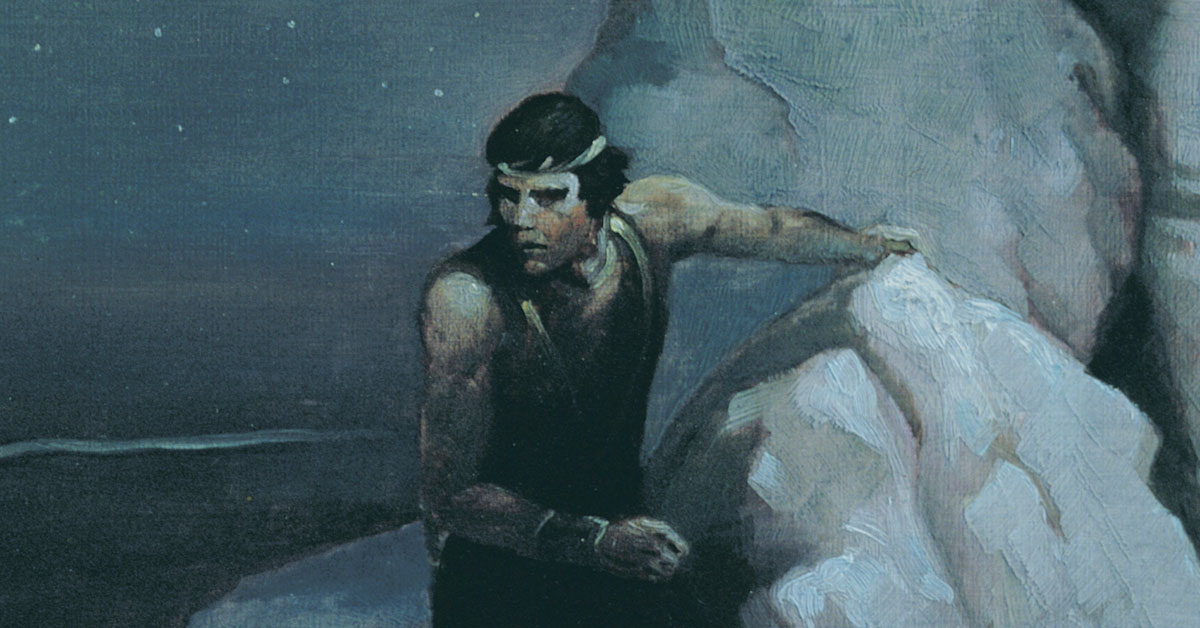You are here
Book of Mormon Central is in the process of migrating to our new Scripture Central website.
We ask for your patience during this transition. Over the coming weeks, all pages of bookofmormoncentral.org will be redirected to their corresponding page on scripturecentral.org, resulting in minimal disruption.

Scripture Block
Ether 12–15
November 23–29 “By Faith All Things Are Fulfilled”
Recommended Resources
Learn about the Book of Mormon with verse by verse commentaries from renowned Book of Mormon scholars like John W. Welch and Brant A. Gardner in the ScripturePlus app. Read this week's KnoWhy connected with the Come Follow Me curriculum, and watch a video elucidating an insight in this week's scripture reading.
KnoWhys
Reading Plan
Structure your personal scripture study by following a multimedia, day by day plan. Each day's assignment includes the required scripture passages from the Come Follow Me curriculum, as well as suggestions for additional resources to bring context and understanding to your study.
Monday
- Scripture: Ether 12:1-6
- KnoWhy 356: How Can Trials of Faith Lead to Spiritual Growth?
- KnoWhy 246: Why Must a Trial of Faith Precede a Witness of Truth?
Tuesday
- Scripture: Ether 12:7-21
-
Quote: “The heavenly gift of which Moroni speaks is the forgiveness of sins, the companionship of the Holy Ghost, and the accompanying gifts of the Spirit that are bestowed upon the just and faithful Saints of God. The Apostle Peter spoke of this gift as ‘the divine nature’ that, through the atoning grace of Christ, swallows up the natural man. Through faith and acceptance of Christ's atoning plan of mercy people can be cleansed of iniquity, transformed into ‘new creatures.’ During the golden era of the Nephite Zion society the people partook of the heavenly gift, which produced a society free from contention and disputation, injustices and inequities, lasciviousness and crime… From the words and examples of faith of these holy men of God as found in the scriptures, Moroni desires that others may also come to have that kind of faith and hope and thereby partake of this heavenly gift.”
McConkie, Joseph Fielding, and Robert L. Millet. Doctrinal Commentary on the Book of Mormon. 4:298. Salt Lake City, UT: Deseret Book, 2007. -
Quote: “One is inclined to say that surely God could block such an experience if he wished to. But the text suggests otherwise: ‘this man . . . could not be kept from within the veil.’ This may be an unprecedented case of a mortal man’s desire, will, and purity so closely approaching the heavenly standard that God could not but honor his devotion. Given such faith, we should not be surprised that the Lord would show…him visions that would be relevant to the mission of all the Book of Mormon prophets and to the events of the latter-day dispensation.”
Holland, Jeffrey R. Christ and the New Covenant. 23–24. Salt Lake City, UT: Deseret Book, 1997.
Wednesday
- Scripture: Ether 12:22-29
- KnoWhy 490: Does the Book of Mormon Really Have “Bad” Grammar?
- KnoWhy 350: How Does Grace Help Us Overcome Weakness?
Thursday
- Scripture: Ether 12:30-41
-
Quote: “We are challenged to move through a process of conversion toward that status and condition called eternal life. This is achieved not just by doing what is right, but by doing it for the right reason—for the pure love of Christ. The Apostle Paul illustrated this in his famous teaching about the importance of charity. The reason charity never fails and the reason charity is greater than even the most significant acts of goodness he cited is that charity, ‘the pure love of Christ’ is not an act but a condition or state of being. Charity is attained through a succession of acts that result in a conversion. Charity is something one becomes. Thus, as Moroni declared, ‘except men shall have charity they cannot inherit’ the place prepared for them in the mansions of the Father.”
Oaks, Dallin H. “The Challenge to Become.” General Conference October 2000. -
Quote: “We should not be discouraged or depressed by our short-comings. No one is without weakness. As part of the divine plan, we are tested to see whether we master weakness or let weakness master us. Proper diagnosis is essential to proper treatment . . . But wishing for strength won’t make us strong. It takes faith and work to shore up a weakened cord of integrity. We know the process of self-repair called repentance.”
Nelson, Russell Marion. Perfection Pending: and Other Favorite Discourses. 25–26. Salt Lake City, UT: Deseret Book Co., 1998. - KnoWhy 1: What Does It Mean to Be a Martyr?
Friday
- Scripture: Ether 13:1-13
- KnoWhy 247: Why Do the Prophets Speak of Multiple Jerusalems?
-
Quote: “It is interesting to note the symbols used here by the Savior to teach the sanctifying, cleansing power of the infinite and eternal sacrifice of the Lamb of God. How do sin-stained garments become pure white when immersed in the blood of Christ? Mortal blood is a staining agent itself, but somehow, spiritually speaking, the blood spilled by a God in our behalf becomes the only true cleansing agent."
McConkie, Joseph Fielding, and Robert L. Millet. Doctrinal Commentary on the Book of Mormon. 4:180. Salt Lake City, UT: Deseret Book, 2007. -
Quote: “I would like to remind all members of the Church of Jesus Christ of Latter-day Saints that you and I have taken upon ourselves the name of Christ through faith, repentance, baptism, and confirmation. All of us have entered into a covenant that we will keep all of God's commandments. The Lord has promised us that if we do so and remain faithful to the end that someday we shall be quickened by a celestial power. At that time we shall rise as celestial beings, and enter into the presence of God. Then the righteous shall be sanctified through the blood of the Lamb and be worthy to dwell in the presence of the Lamb of God forevermore.”
Hunter, Milton R. “Through the Blood of the Lamb.” General Conference April 1958. - Scripture: Ether 13:14-31
-
Quote: “Ether, the heir apparent to the Jaredite throne, was rejected by the people in power . . . The fact that Ether was the grandson of a deposed king and that he was making accusations against king Coriantumr must have created a strong bias against him. Because both his person and his message were unwelcome in Coriantumr’s court, Ether had to flee for his life. He lived without influence among the people rather than as a king in a castle. In fact, he was considered to be an enemy, and lived as a recluse in a cave. He warned the people, observed the war by night, and recorded the tragic events.”
LeBaron, E. Dale. “Ether and Mormon: Parallel Prophets of Warning and Witness.” In The Book of Mormon: Fourth Nephi through Moroni, from Zion to Destruction. Papers from the Ninth Annual Book of Mormon Symposium, 1994, edited by Monte S. Nyman and Charles D. Tate, 154. Salt Lake City, UT: Religious Studies Center, 1995.
Saturday
- Scripture: Ether 14:1-31
-
Quote: “Our first encounter with Shiz in the scriptures introduces his insensitivity, for he ‘did slay both women and children, and he did burn the cities.’ We see in the rivalry of Shiz and Coriantumr, as in other Book of Mormon episodes, an awful cycle of family vengeance. Those who are caught up in revenge lose all perspective concerning the sanctity of life. Shiz swore to ‘avenge himself upon Coriantumr of the blood of his brother.’ That Shiz was an intimidating individual is made perfectly clear by the quailing question, ‘Who can stand before the army of Shiz?’”
Maxwell, Neal A. “Three Jaredites: Contrasting Contemporaries.” Ensign, August 1978. -
Quote: “Coriantumr and Shared became obsessed with the necessity of ridding the world of each other. When Shared defeated one of Coriantumr’s armies, he raced to the capital and put himself on the man’s throne. But the process of polarization then began in earnest. Coriantumr gathered ‘great strength to his army’ . . . while Gilead, the brother and successor of Shared, was doing the same, assisted by secret combinations. The[y] were dangerous associates, however, for they soon murdered Gilead and then . . . his murderer, while a giant by the name of Lib . . . became king. He was killed fighting Coriantumr, but his brother continued the feud—he was the famous Shiz. . . . Always this steady, progressive process of polarization goes on.”
Nibley, Hugh. Teachings of the Book of Mormon. 4:257–258. Provo, UT: Foundation for Ancient Research and Mormon Studies, 1990. -
Quote: “These painful consequences of war were the direct result of their own wickedness, which in turn produced a literal fulfillment of earlier prophecies wherein the Lord had promised peace and protection to the inhabitants of this land if they would obey him and destruction if they did not . . . . Much if not all of the pain and suffering that could be viewed as ‘the wrath of God’ came by means of the meanness, the cruelty, and the thirst for blood that filled the hearts of the spiritually sick and dead.”
McConkie, Joseph Fielding, and Robert L. Millet. Doctrinal Commentary on the Book of Mormon. 4:313. Salt Lake City, UT: Deseret Book, 2007.
Sunday
- Scripture: Ether 15:1-11
-
Quote: “There for us to ponder also is a clear case in which personal pride and rage kept two principals from acting for the welfare of their people. Shiz insisted on ‘getting his man,’ even if it meant the destruction of his own people; and Coriantumr offered his kingdom but not his life for his people. Each said, in effect, that the ultimate object of his selfishness was nonnegotiable! Neither was willing to play the role of the intervener and say of the circumstances, ‘This has gone too far—enough is enough.’ How often on a lesser scale in human affairs do tinier tragedies occur for want of this selfless intervention?”
Maxwell, Neal A. “Three Jaredites: Contrasting Contemporaries.” Ensign, August 1978. - Scripture: Ether 15:12-34
-
Quote: “[T]he chapters recounting the Jaredite demise (Ether 13-15) feature a rejection of God’s prophets, escalating warfare, a polarized society in which everyone is swept up by one side or the other, a gathering for the final battle, and then a cataclysmic conclusion. It . . . sounds somewhat like Mormon’s account of the end of the Nephites. However, Moroni never points out the rather significant differences: Jaredite troubles arose from rival factions among the leadership rather than from competing ethnic groups, the last prophet had no role in the struggles, the two forces were fairly evenly matched, and one side did not successfully conquer the other.”
Hardy, Grant. Understanding the Book of Mormon: A Reader's Guide. 229. New York: Oxford University Press, 2010. - KnoWhy 248: How Could Shiz Move and Breathe After Being Beheaded?
Additional Resources (Bibliography)
Ether 12
Garrett, H. Dean. “Light in Our Vessels: Faith, Hope, and Charity.” In The Book of Mormon: Fourth Nephi Through Moroni, From Zion to Destruction, edited by Monte S. Nyman and Charles D. Tate, Jr., 81–93. Provo, UT: Religious Studies Center, 1995.
Thomas, Mark D. “Moroni: The Final Voice.” Journal of Book of Mormon Studies 12, no. 1 (2003): 88–99, 119-120.
Welch, John W., and Greg Welch. “Plausible Locations of the Final Battles.” In Charting the Book of Mormon: Visual Aids for Personal Study and Teaching. Provo, UT: Foundation for Ancient Research and Mormon Studies, 1999, chart 159.
Ether 12:6
Book of Mormon Central. “How Can Trials of Faith Lead to Spiritual Growth? (Ether 12:6).” KnoWhy 356 (August 23, 2017).
Book of Mormon Central. “Why Must a Trial of Faith Precede a Witness of Truth? (Ether 12:6).” KnoWhy 246 (December 6, 2016).
Ether 12:7
Tvedtnes, John A. “The Timing of Christ's Appearance to the Nephites.” In The Most Correct Book: Insights from a Book of Mormon Scholar, 251–269. Salt Lake City: Cornerstone Publishing, 1999.
Ether 12:23–25
Book of Mormon Central. “Does the Book of Mormon Really Have “Bad” Grammar? (Ether 12:25).” KnoWhy 490 (December 4, 2019).
Book of Mormon Central. “Why is the Book of Mormon a Classic? (Ether 12:25).” KnoWhy 63 (March 26, 2016).
Hatch, Gary Layne. “Mormon and Moroni: Father and Son.” In The Book of Mormon: Fourth Nephi Through Moroni, From Zion to Destruction, edited by Monte S. Nyman and Charles D. Tate, Jr., 105–115. Provo, UT: Religious Studies Center, Brigham Young University, 1995.
Welch, John W., David Fox, Roger R. Keller, Paul Y. Hoskisson, Deloy Pack, Robert F. Smith, and Bruce W. Warren. “Words and Phrases.” In Reexploring the Book of Mormon, edited by John W. Welch, 282–285. Provo, UT/Salt Lake City: FARMS/Deseret Book, 1992.
Ether 12:27
Book of Mormon Central. “How Does Grace Help Us Overcome Weakness? (Ether 12:27).” KnoWhy 350 (August 9, 2017).
Rasmus, Carolyn J. “’Weak Things Made Strong.’” In The Book of Mormon: Fourth Nephi Through Moroni, From Zion to Destruction, edited by Monte S. Nyman and Charles D. Tate, Jr., 251–262. Provo, UT: Religious Studies Center, 1995.
Reynolds, Noel B. “’Come unto Me’ as a Technical Gospel Term.” Interpreter: A Journal of Latter-day Saint Faith and Scholarship 31 (2019): 1–24.
Ether 12:35
Hilton, John III, Ryan Sharp, Brad Wilcox, and Jaron Hansen. “Gentiles in the Book of Mormon.” Interpreter: A Journal of Latter-day Saint Faith and Scholarship 33 (2019): 267–288.
Ether 12:37–39
Book of Mormon Central. “What Does It Mean to Be a Martyr? (Ether 12:37, 39).” KnoWhy 1 (January 1, 2016).
Welch, John W., and Greg Welch. “People to Whom Jesus Christ or the Angel of the Lord Appeared.” In Charting the Book of Mormon: Visual Aids for Personal Study and Teaching. Provo, UT: Foundation for Ancient Research and Mormon Studies, 1999, chart 41.
Ether 13
Brinley, Douglas E. “The Jaredites—A Case Study in Following the Brethren.” In The Book of Mormon: Fourth Nephi Through Moroni, From Zion to Destruction, edited by Monte S. Nyman and Charles D. Tate, Jr., 45–59. Provo, UT: Religious Studies Center, Brigham Young University, 1995.
O’Driscoll, Jeff. “Zion Zion Zion: Keys to Understanding Ether 13.” In The Book of Mormon: Fourth Nephi Through Moroni, From Zion to Destruction, edited by Monte S. Nyman and Charles D. Tate, Jr., 215–234. Provo, UT: Religious Studies Center, 1995.
Welch, John W., and Greg Welch. “Plausible Locations of the Final Battles.” In Charting the Book of Mormon: Visual Aids for Personal Study and Teaching. Provo, UT: Foundation for Ancient Research and Mormon Studies, 1999, chart 159.
Ether 13:1–13
Bowen, Matthew L. “’They Shall No More Be Confounded’: Moroni’s Wordplay on Joseph in Ether 13:1-13 and Moroni 10:31.” Interpreter: A Journal of Mormon Scripture 30 (2018): 91–104.
Ether 13:3–6
Book of Mormon Central. “Why Do the Prophets Speak of Multiple Jerusalems? (Ether 13:3–6).” KnoWhy 247 (December 7, 2016).
Ether 13:25–31
Bowen, Matthew L., and Pedro Olavarria. “Place of Crushing: The Literary Function of Heshlon in Ether 13:25–31.” Interpreter: A Journal of Mormon Scripture 14 (2015): 227–239.
Ether 14
Brinley, Douglas E. “The Jaredites—A Case Study in Following the Brethren.” In The Book of Mormon: Fourth Nephi Through Moroni, From Zion to Destruction, edited by Monte S. Nyman and Charles D. Tate, Jr., 45–59. Provo, UT: Religious Studies Center, Brigham Young University, 1995.
Welch, John W., and Greg Welch. “Plausible Locations of the Final Battles.” In Charting the Book of Mormon: Visual Aids for Personal Study and Teaching. Provo, UT: Foundation for Ancient Research and Mormon Studies, 1999, chart 159.
Ether 15
Anonymous. “Out of the Dust.” Journal of Book of Mormon Studies 8, no. 2 (1999): 82–83, 88.
Brinley, Douglas E. “The Jaredites—A Case Study in Following the Brethren.” In The Book of Mormon: Fourth Nephi Through Moroni, From Zion to Destruction, edited by Monte S. Nyman and Charles D. Tate, Jr., 45–59. Provo, UT: Religious Studies Center, Brigham Young University, 1995.
Roper, Matthew (2003) “Nephi’s Neighbors: Book of Mormon Peoples and Pre-Columbian Populations,” Review of Books on the Book of Mormon 15, no. 2 (2003): 91–128.
Roper, Matthew. Nephi’s Neighbors: Book of Mormon Peoples and Pre-Columbian Populations In 2003 FAIR Conference. Orem, UT: FairMormon, 2003.
Sorenson, John L. “When Lehi’s Party Arrived in the Land, Did They Find Others There?” Journal of Book of Mormon Studies 1, no. 1 (1992): 1–34.
Welch, John W., and Greg Welch. “The Two Final Battles.” In Charting the Book of Mormon: Visual Aids for Personal Study and Teaching. Provo, UT: Foundation for Ancient Research and Mormon Studies, 1999, chart 138.
Welch, John W., and Greg Welch. “Plausible Locations of the Final Battles.” In Charting the Book of Mormon: Visual Aids for Personal Study and Teaching. Provo, UT: Foundation for Ancient Research and Mormon Studies, 1999, chart 159.
Ether 15:29–32
Book of Mormon Central. “How Could Shiz Move and Breathe After Being Beheaded? (Ether 15:31).” KnoWhy 248 (December 8, 2016).
Hadfield, Gary M. and John W. Welch. “The ‘Decapitation’ of Shiz.” Insights: A Window on the Ancient World 14, no. 6 (1994): 2.
Hadfield, Gary M. “Neuropathology and the Scriptures.” BYU Studies Quarterly 33, no. 2 (1993): 312–328.
Roper, Matthew. “Book of Mormon Swords in Mesoamerican Antiquity.” Insights: A Window on the Ancient World 28, no. 2 (2008): 2–3.





